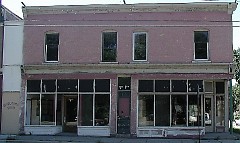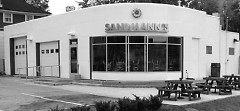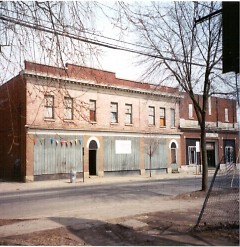I keep hearing people talk about the effects of gentrification in Uptown but can find no substantive evidence of it. This idea of gentrification has recently caused some silly people to do some dumb things in my neighborhood. From the evidence that I can find, gentrification in Uptown is a myth.
Myth #1: Poor people are being forced out of the neighborhood due to increased property values and rental rates.
There is no evidence of this, in fact most of the evidence points in the opposite direction - there is an ample supply of affordable housing options in Uptown as well as most of City. The neighborhood has consciously worked to ensure that a wide variety of housing options are available including options for low-income residents. Lighthouse Communities built the Uptown Village Apartments and Townhouses at the corner of Wealthy and Diamond to ensure high-quality low-income housing. Currently, Habitat for Humanity and Dwelling Place of Grand Rapids are working on a project in Wealthy Heights, that will provide low-income home ownership opportunities.
Myth #2: New businesses are forcing out businesses that serve the neighborhood.
Myth #3: New businesses do not fit into the community, i.e. provide no community benefit.
The majority of new businesses in the Uptown area have filled vacant store fronts, empty buildings, and new developments - not displacing existing businesses. We have seen the area transform from boarded up buildings to active businesses to the benefit of the entire community. Blaming the failure of a business on a reviving business district is absurd. Most business failures are caused by poor planning, not having a business plan or marketing plan. The businesses that have failed in the Uptown area are as diverse as the ones that have been successful. New businesses are not forcing others out of business but are adding to the diversity of goods and services in the neighborhood. The idea that every business should serve the needs of everyone in the community is another point of absurdity. Business does not function on an egalitarian model, this have proved out on the world stage over and over again. An active business district reverses the flow of disinvestment, bringing more capital into the community, generating revenue for our city thus allowing the city to continue to provide services. Additionally, the businesses in Uptown, especially on Wealthy Street, have been actively engaged with the broader community in which they exist.
Myth #4: Gentrification is a real thing, Uptown is being invaded.
What we are seeing in Uptown is re-investment after decades of dis-investment. The Uptown area has historically been a place of mixed incomes, we have great historical markers that make direct evidence of the history of this community, all one needs to do is look at the housing stock. Our community has always been composed of people of greatly varying income levels - some lived in large houses others in small houses or apartments. The idea that this area of the city has historically been primarily poor is a misnomer, it has always been mixed. In the 60s and 70s there was massive disinvestment that led to a temporary decline that is now being corrected. This is not "new" development but the return of what was here - an active thriving neighborhood with active thriving businesses. New infill that is being built is merely replacing neglected property that had been demolished and left vacant. No invasion is happening, just a 30 year long slow trickle of re-investment that is re-making what was here before.
The Rapidian, a program of the 501(c)3 nonprofit Community Media Center, relies on the community’s support to help cover the cost of training reporters and publishing content.
We need your help.
If each of our readers and content creators who values this community platform help support its creation and maintenance, The Rapidian can continue to educate and facilitate a conversation around issues for years to come.
Please support The Rapidian and make a contribution today.




Comments
Kick ass column offering a fact-based analysis of an evolving neighborhood.
Anyone who wants to gentrify the area can buy my house.
Thanks for this great article. It's what I've been thinking since I saw it all on Christmas morning (kinda ruined my morning that day)
The mixture of types of businesses and people is what makes Uptown a great place to live and I see it staying diverse in every way for a LONG time (hopefully forever!)
Having lived just off of Wealthy Street for 35 years, I can appreciate Mark's response to those who have expressed concern about gentrification. I recognize the positive developments in Uptown and take advantage of them all the time. I also recognize that, particularly if you are black and have grown up in the area, the changes can feel uncomfortable. I recently hung out for a while with a group of young, unemployed black men from the Wealthy and Diamond area who believed that the door person at the entrance to the Meanwhile was there to keep them out. As far-fetched as that seemed to me, the feeling of exclusion was real to them.
My hope for our community is that we can hold on to our tendency to react defensively and listen carefully to those who feel disenfranchised by the economic development that is ocurring in our neighborhood. Listening to and supporting each other is what builds community and has been the foundation of the urban renewal along Wealthy and Cherry streets that I've watched and participated in for over three decades. My hope is that everyone can participate in the renewal. I suspect that we'll have to keep listening and working if we really want that to happen.
Commissioner Talen,
thank you for your comment. It is that level of "discomfort" that most worries me about the renewal. I take great pride in the neighborhood in which I live, but I do get the feeling that attempts at inclusion are not being fully made.
It is interesting that you mention the Meanwhile. As a door person at The Meanwhile I can say without hesitation that the statements espoused by the people you were hanging out with are 100% false. With that in mind however, I do not find it difficult to believe that some people would feel that way.
dear jim talen.
this is the best response i have read concerning the recent vandalisms. your words are much appreciated.
marlee
As posted on GRIID:
After reading and thinking about what has been said here, along with living and being active in the discussed neighborhood and working on these issues at a professional level, I think we are dealing with an “and/both” situation (as opposed to either/or).
Let me preface my comments by saying I in no way condone the actions of the vandals. I frequent all of the affected establishments and know most of the proprietors well. Although their actions have undoubtedly caused a stir, they are not an effective way of creating change. I think it is sad that these already small business owners, none of which are making millions of dollars (unlike Walmart who we all should be criticizing), have yet another obstacle to overcome.
That said, as a very strong supporters of the local business movement (over 75% of all of my purchases are by businesses in the neighborhood, city, county, state, and region), I think East Hills is at a pinnacle point in its revitalization. The damage that white flight has caused our Central City neighborhoods, only exacerbated by the foreclosure crisis, will take years to repair. There is no doubt that local and federal policy has encouraged the decades of disinvestment into our urban core. To see such strong growth in our neighborhood during tough economic times is incredible. As this neighborhood and city continue to revitalize (which all national studies say urban centers will do) we need to ensure that this neighborhood’s roots are preserved. We need revitalization, thriving business districts, restaurants, shops, bars, etc. for all people in the neighborhood as our goal should be to build an integrated, diverse (racially, economically, family styles, etc) community.
Is East Hills “gentrified” (as defined by academics that study this issue)? No. We are rebounding back from decades of disinvestment and a bearish market. We have had incredible growth and changed a lot in fifteen years. We look nothing like Ann Arbor, SOHO, Greenwhich Village, Lincoln Park, and other truly gentrified areas. If we continue on the path taken in the last ten years we could become that. I live on Wealthy near Diamond and from what I understand from long time residents and community activists, I believe nobody would pay in rent what I pay now to live on Wealthy Street. Also, working in the housing business, I know I could get a lot cheaper two-bedroom apartment in another, not so “cool,” neighborhood for less (not a lot, maybe $100-$150 less a month at the most). The neighborhood has improved and maybe some rentals are able to obtain more income, but it is not huge percentages. Looking at the fair market rents as reported by HUD for the last twenty years, City wide rent prices have not increase dramatically (outside of the rate of inflation). That is not neighborhood specific data, but more anecdotal information (which is largely all we have) have shown an increase in rent due to an increase in demand (demand driven by a revitalized area). Although, rents in East Hills are not terribly out of line with city and metro region wide standards. The average two bedroom rent for Grand Rapids/Wyoming is $749 (HUD 2009 FMR). I don’t pay much more than that and I live in East Hills.
I think this is an “and/both” situation. We need revitalization. We don’t need gentrification. We are not gentrified, but if we continue the path we are on we could become so. We need to preserve the historic minority populations in East Hills (along with business that cater to them).
On the issue of businesses, and as someone who frequents most of the mentioned establishments and notices who else does as well, a strong portion of the businesses does not always cater to the neighborhood. There is a lot of people from the suburbs and East that eat at The Electric Cheetah, Winchester, and others. Some businesses are frequented more by non-neighborhood folk that others. It is without a doubt that our neighborhood has become some-what of a destination. This is a significant change than from ten years ago. Is this bad you ask? No, not necessarily. I am very OK with people coming to spend their money in our neighborhood. We must though maintain our diverse population that will continue to attract people here. We need diversity and integration.
Although I disagree with many elements of Ms. Wheeler’s article, I do thank her for opening up the discussion. I think we need growth, revitalization, economic development, and new business that cater to all types of people. I also think that we need make some serious decisions for the future and how we plan our neighborhood so it does not become gentrified but maintains its integration. It is a fine line and we must walk it carefully.
Thank you for opportunity to comment.
p.s.I am more than willing to help organize a public forum to discuss these issues. Also, people who are interested in becoming active in the East Hills community should get in touch with the neighborhood association.
As a 20 year resident of the East Hills neighborhood, I'd love to get the ages of the vandals. I suspect they are not even old enough to remember all the empty buildings, not to mention houses, in our part of town. If they are young, they should keep that fact of blight in mind. I am very happy to have these businesses here, and believe there is room for others as well. Tyler, I agree that gentrification is, at the moment, not something we need fear. Let's deal with what we have now.
And a very interesting and important topic. Thank you for brining it to our attention - I didn't know the subject was being debated right now, though I'm not surprised. However, I'm not convinced by your article that gentrification isn't happening in Uptown. (I really don't have an opinion yet.)
I think that if you want to disprove the myth of uptown gentrification, you should use hard-and-fast statistics/data. How have income levels changed (if they have at all)? How have property values changed? How has rental property pricing changed? What is the ratio of local to chain retailers in the area and how is it different than in years past? What is the percentage of uptown vacancies now as opposed to 10 or 20 or 30 years ago? Have the efforts by the two development projects you mentioned come close to providing enough housing for the population they're trying to serve?
I also am unsure that you should say gentrification is a myth and that it's happening in Uptown is a myth all in one statement. Gentrification is not a myth. Is it happening in Uptown? Lets see some research. If it is happening (even if it's only in the very early stages), how should it be approached as a social justice issue?
This might make an interesting study using GIS. Mark Hoffman at GVSU's School of Public and Nonprofit Administration might be interested in offering the idea to his students as a research topic.
Hi Summer,
I think an important thing to keep in mind is that "gentrification" is more than simply numbers regarding housing costs and whatnot. However this issue was quite hotly debated on GRIID last week. I encourage you to read the article and some of the comments. However I think this comment is fairly blunt in showing that gentrification is not happening, at least fiscally speaking.
Thank you Nick for pointing to the context of this article and comments, which I hadn't seen before.
I think you're right - the comment does do an excellent job of showing how it's unlikely that, given the numbers, gentrification is happening. My first though when reading this article was "Uh, we're in a massive recession. What upscaling?"
Of course, in recessions and depressions, a lot of folk tend to move back to the city from the now unaffordable suburbs (and, historically speaking, broken farms). Others move back to the city to cut down on their commute time/gas costs, eventually raising the rent prices and pushing out the poorer residents. But without data, I don't feel informed enough to have an opinion one way or the other.